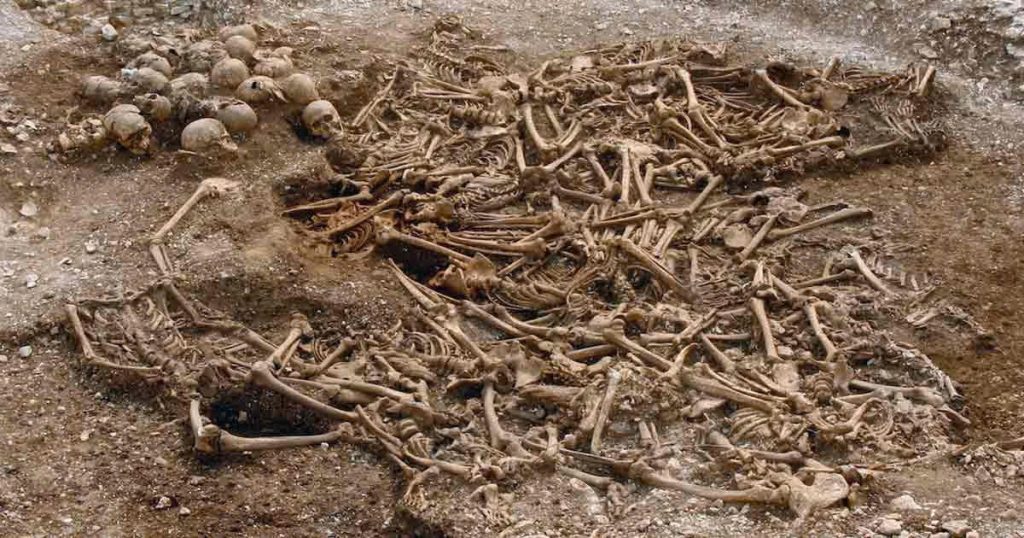In a remarkable and chilling archaeological discovery, the remains of 51 young Viking men were unearthed near Weymouth, United Kingdom, offering a haunting glimpse into the brutal and violent conflicts that characterized the early 11th century. This find sheds light on the tumultuous relationship between the Anglo-Saxons and the Norse invaders, painting a vivid picture of the stark realities of medieval warfare and the ruthless measures taken by both sides.
The discovery, made in June 2009 during a routine preconstruction survey conducted by Oxford Archaeology, revealed a macabre and unforgettable scene. In a mass grave, archaeologists uncovered the decapitated bodies of 51 men, all stripped of their clothing. The severed heads of the victims were meticulously stacked to one side, creating a tableau that is as gruesome as it is informative. The grave, dating back roughly a thousand years, offers an invaluable snapshot of the past, encapsulating the violence and cultural tensions that defined this era.

Scientific analysis has played a pivotal role in unraveling the story behind these remains, particularly through advanced isotope testing. By examining the teeth of ten of the victims, researchers were able to uncover critical details about their origins and way of life. These tests revealed that the men lived between 910 and 1030 AD and hailed from various parts of Scandinavia, with some even originating from regions north of the Arctic Circle. Their diet, rich in protein, further aligned with dietary patterns observed in other Swedish remains from the same period.
The diversity of the group is a particularly striking aspect of the discovery. The evidence suggests that these men were part of a Viking raiding party, recruited from across Scandinavia. Unlike the ethnic Danes who had settled in northern Britain and could have also clashed with the Anglo-Saxons, this group appears to have been a more transient assembly of warriors united by a common cause. Their varied origins underscore the far-reaching influence of Viking culture and the extensive networks that enabled them to stage raids and military campaigns across Europe.
The brutal manner of their deaths provides chilling insight into the harsh realities of medieval conflict. The skeletons bear unmistakable signs of deliberate and systematic execution. Deep cuts on skulls, jaws, and necks indicate that beheading was the chosen method, while some victims displayed sliced fingers, likely the result of desperate attempts to defend themselves. The state of the bodies—naked and stripped of any possessions—along with the grave’s prominent hilltop location, aligns closely with documented Saxon practices for executing enemies. Such methods were likely intended not only to eliminate threats but also to serve as stark warnings to others who might dare to challenge the Anglo-Saxon rule.
The context of this violent execution becomes clearer when considering the broader historical backdrop. During the height of the Viking Age, Norse raiders frequently targeted Anglo-Saxon territories, leveraging their advanced seafaring skills and superior numbers to stage devastating attacks. While both sides were comparably equipped in battle, the Vikings often held the advantage of surprise, launching sudden raids that caught their enemies off guard. The Anglo-Saxons, in turn, adopted increasingly severe measures to defend their lands and punish those who dared to invade. The systematic execution of these Viking warriors is a stark example of such measures, highlighting the extreme lengths to which both sides were willing to go in this era of relentless conflict.
The discovery near Weymouth also serves as a sobering reminder of the personal toll of these violent clashes. The young age of the victims adds an especially poignant dimension to the find, emphasizing the human cost of the era’s relentless struggles. These men, likely in the prime of their lives, were caught up in a cycle of invasion and reprisal that left little room for mercy or compromise. Their remains stand as silent witnesses to the suffering and brutality that defined medieval warfare.
This archaeological find offers more than just a glimpse into a single violent episode—it also contributes to a deeper understanding of the complex dynamics that shaped medieval Britain. The interactions between the Anglo-Saxons and the Vikings were not limited to warfare; they also encompassed trade, cultural exchange, and, eventually, a degree of integration. However, this grave starkly underscores the darker side of their relationship, reminding us of the intense and often violent competition for dominance that characterized much of this period.
The legacy of the Viking Age continues to capture the imagination of historians and the public alike, in part because of finds like this one. The systematic execution of these young men offers a dramatic and tangible link to the past, bringing to life the stories of individuals who lived and died in a world vastly different from our own. Yet, despite the distance of centuries, their story resonates with universal themes of conflict, resilience, and the human capacity for both cruelty and survival.
As author Kim Siddorn aptly observed, “During the height of the Viking raids, it’s reasonable to say it was unsafe to live anywhere within 20 miles of the coast.” This statement underscores the pervasive fear and insecurity that shaped daily life in these regions, as communities grappled with the constant threat of attack. The grave near Weymouth encapsulates this atmosphere of danger, serving as a powerful testament to an era when survival often depended on strength, strategy, and a willingness to fight to the bitter end.
Ultimately, this discovery is not just a grim reminder of the violence of the past—it is also a valuable resource for understanding the forces that shaped medieval Europe. The remains of these young Viking warriors provide a rare and compelling window into a world of conflict and cultural interaction, offering insights that continue to inform our understanding of history. Their story, though marked by tragedy, serves as a lasting testament to the resilience and complexity of human societies in even the most turbulent of times.





